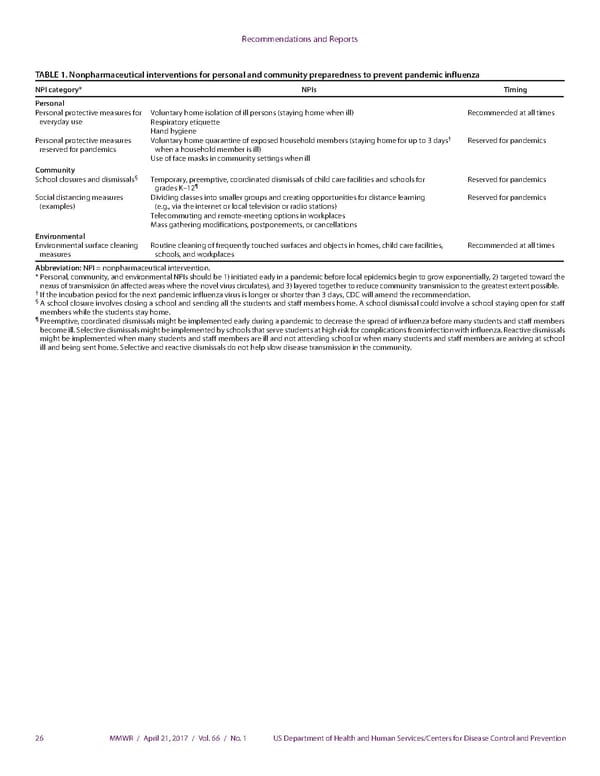Recommendations and Reports TABLE 1. Nonpharmaceutical interventions for personal and community preparedness to prevent pandemic influenza NPI category* NPIs Timing Personal Personal protective measures for Voluntary home isolation of ill persons (staying home when ill) Recommended at all times everyday use Respiratory etiquette Hand hygiene † Personal protective measures Voluntary home quarantine of exposed household members (staying home for up to 3 days Reserved for pandemics reserved for pandemics when a household member is ill) Use of face masks in community settings when ill Community § School closures and dismissals Temporary, preemptive, coordinated dismissals of child care facilities and schools for Reserved for pandemics ¶ grades K–12 Social distancing measures Dividing classes into smaller groups and creating opportunities for distance learning Reserved for pandemics (examples) (e.g., via the internet or local television or radio stations) Telecommuting and remote-meeting options in workplaces Mass gathering modifications, postponements, or cancellations Environmental Environmental surface cleaning Routine cleaning of frequently touched surfaces and objects in homes, child care facilities, Recommended at all times measures schools, and workplaces Abbreviation: NPI = nonpharmaceutical intervention. * Personal, community, and environmental NPIs should be 1) initiated early in a pandemic before local epidemics begin to grow exponentially, 2) targeted toward the nexus of transmission (in affected areas where the novel virus circulates), and 3) layered together to reduce community transmission to the greatest extent possible. † If the incubation period for the next pandemic influenza virus is longer or shorter than 3 days, CDC will amend the recommendation. § A school closure involves closing a school and sending all the students and staff members home. A school dismissal could involve a school staying open for staff members while the students stay home. ¶ Preemptive, coordinated dismissals might be implemented early during a pandemic to decrease the spread of influenza before many students and staff members become ill. Selective dismissals might be implemented by schools that serve students at high risk for complications from infection with influenza. Reactive dismissals might be implemented when many students and staff members are ill and not attending school or when many students and staff members are arriving at school ill and being sent home. Selective and reactive dismissals do not help slow disease transmission in the community. 26 MMWR / April 21, 2017 / Vol. 66 / No. 1 US Department of Health and Human Services/Centers for Disease Control and Prevention
 Community Mitigation Guidelines to Prevent Pandemic Influenza Page 27 Page 29
Community Mitigation Guidelines to Prevent Pandemic Influenza Page 27 Page 29